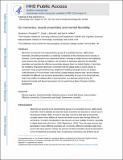On memories, neural ensembles and mental flexibility
Author(s)
Pinotsis, Dimitris A.; Brincat, Scott Louis; Miller, Earl K
DownloadAccepted version (3.821Mb)
Terms of use
Metadata
Show full item recordAbstract
Memories are assumed to be represented by groups of co-activated neurons, called neural ensembles. Describing ensembles is a challenge: complexity of the underlying micro-circuitry is immense. Current approaches use a piecemeal fashion, focusing on single neurons and employing local measures like pairwise correlations. We introduce an alternative approach that identifies ensembles and describes the effective connectivity between them in a holistic fashion. It also links the oscillatory frequencies observed in ensembles with the spatial scales at which activity is expressed. Using unsupervised learning, biophysical modeling and graph theory, we analyze multi-electrode LFPs from frontal cortex during a spatial delayed response task. We find distinct ensembles for different cues and more parsimonious connectivity for cues on the horizontal axis, which may explain the oblique effect in psychophysics. Our approach paves the way for biophysical models with learned parameters that can guide future Brain Computer Interface development. ©2017 Elsevier Inc.
Date issued
2017-06Department
Picower Institute for Learning and Memory; Massachusetts Institute of Technology. Department of Brain and Cognitive SciencesJournal
NeuroImage
Publisher
Elsevier BV
Citation
Pinotsis, Dimitris A. et al., "On memories, neural ensembles and mental flexibility." NeuroImage 157 (August 2017): p. 297-313 doi. 10.1016/j.neuroimage.2017.05.068 ©2017 Authors
Version: Author's final manuscript
ISSN
1095-9572